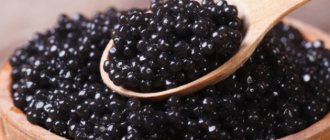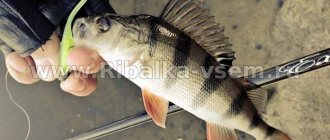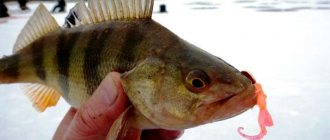- Extraction and production What kind of fish is it obtained from?
- Where is it mined?
- Season
- Color
- By processing
Five rubles - that’s how much a jar of black caviar cost in the USSR.
Remember the scene from the film “Ivan Vasilyevich changes his profession”? All the dishes on the royal table were not props: Leonid Gaidai spent as much as 200 rubles (the average salary in the country!) on delicacies, among which was a huge bowl of sturgeon caviar. By the way, it is considered an original Russian delicacy, because the main places for fishing were the Amur and Danube rivers. Another interesting fact about the product: experts recommend eating it exclusively with a silver spoon, otherwise the taste of the delicacy will change for the worse. What does a gourmet need to know in order to choose the right caviar, what types there are and how not to run into a fake?
Mining and production
Poaching has led to sad consequences: in their natural habitat, sturgeon are on the verge of extinction. Therefore, now the catch of this family of fish is controlled at the legislative level.
Wild caught sturgeon
What kind of fish does it come from?
There are several varieties of black caviar depending on the type of sturgeon fish:
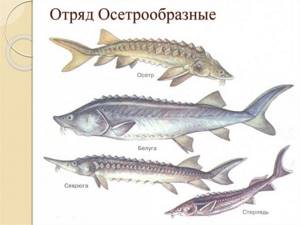
Types of sturgeon fish
- From beluga.
The most expensive and largest, it ranks first in taste and nutritional properties. The shell of the eggs is thin, tender and literally melts in your mouth. The fish can gain weight up to 400 kg, with eggs accounting for up to 25% of the mass, but spawning does not happen every year. - From sturgeon.
Smaller and cheaper, but the price depends on the age of the fish - if an individual is older than 15 years, caviar will cost more. It can weigh up to 200 kilograms and grow up to 2 meters. Sexual maturity of the fish occurs at 9 years. - From stellate sturgeon.
The differences are the high fat content, small size and elasticity. The weight of the female does not exceed 25 kilograms, and the length of the body is 1.5 meters; spawns when it reaches 8 years of age. - From sterlet.
The most budget option. On average, this fish grows up to 60 cm, gaining weight up to 2 kilograms. Spawning occurs at 7-8 years of life.
Where is it mined?
Sturgeon are among the most ancient fish species: they have been known in fossil form since the Cretaceous period (about 70-80 million years ago).
Some fish from the family are classified as so-called anadromous: they live in the sea and move to rivers to spawn.
| View | Sea or river | Where is it found? |
| Beluga | Checkpoint | Azov, Caspian seas; spawning in Terek, Kura, Vyatka, on the Volga, Ural, Don, Kuban |
| Sturgeon | Caspian, Black, Azov seas; spawning on the Volga, Kuban, Don, Tuapse, rarely in the Kama | |
| Stellate sturgeon | Caspian and Azov seas; rises to the Volga, Kuban, Laba, Don, Ural | |
| Sterlet | Freshwater | Volga, Irtysh, Ob, Don, Northern Dvina, Ladoga and Lake Onega basins. Later they artificially settled in the Neman, Amur and Pechora |
The production of black caviar in Russia has been developed since ancient times. However, since the beginning of the 90s of the last century, the sturgeon population in the Caspian Sea has decreased by almost 40 times, and on the Volga - by 15. In this regard, fishing in open waters for the purpose of obtaining black caviar is prohibited by law. Hunting for fish from the Red Book is possible only in “pay zones” outside the spawning period and with a special permit. Now all legal sturgeon caviar is produced in artificial conditions - in aquaculture enterprises.
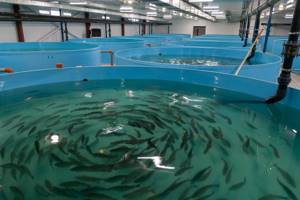
Artificial cultivation of sturgeon
Season
Sturgeon spawning occurs in the spring and summer. However, the migration of females from seas to rivers is observed at different times:
- Winter individuals. They go to spawn immediately before laying eggs - in the spring.
- Spring The period of movement is autumn, when the eggs are not yet ripe.
By the way, these seasonal “races” can even form within one species, depending on the habitat.

Sturgeon in the wild
Then the females return to their permanent place of residence: during this period they have a minimal amount of fat in their body. Meanwhile, the fry grow up and then follow their parents.
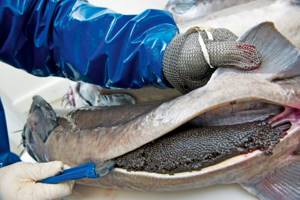
Black caviar extraction
When poaching methods of caviar extraction, the female sturgeon dies (slaughter method), but in many fish farms they use “caesarean section”: individuals live a long time and spawn approximately once every two years. There is also “milking”: the eggs are painstakingly decanted.
Selecting and storing caviar correctly
Many people don’t even know what kind of caviar sterlet has and buy a fake. At best, it turns out to be pike caviar, at worst - artificial substitutes with flavoring additives and dyes.
Manufacturers use different types of packaging. It can be metal, glass, or plastic. The good thing about a glass jar is that you can see the contents through its transparent walls and make sure that it is of proper quality.
The composition can only contain caviar itself, salt and a food additive - a preservative, which allows you to preserve the product in a closed package for up to 10 months. Only vacuum packaging guarantees long-term storage without loss of taste.
Sterling caviar is a healthy and nutritious product, but to preserve its properties it is important to store it properly. Never cool caviar to a temperature below - 6C. It should be served on a caviar plate made of glass, porcelain, or ceramics. Metal adds flavor and it heats up quickly on wood. Some restaurants have large caviar bowls lined with crushed ice.
When purchasing, focus on the following parameters:
- The size of sterlet eggs is from 2 to 2.5 mm;
- Color black, gray-black;
- The shell is soft and sensitive.
Tsar-Ikra.rf
Types and varieties
The quality of black caviar largely depends on how it was processed and packaged. Research the pros and cons of each type before purchasing.
By processing
There are six stages of caviar maturity. The degree is determined in aquaculture farms using ultrasound. So, the granular caviar goes to the 4th stage, the pressed caviar - the 3rd stage, and the ovary caviar - the 2nd stage.
| Type of salting | Characteristics |
| Grainy | The best, most mature, elastic, without deformation are selected. It is cleaned from the shell bag and salted in a dry way. Depending on the consistency, smell, taste, and size of the grains, premium, 1st and 2nd grades are distinguished. But in any case, this particular variety is considered the highest quality. |
| Payusnaya | They use eggs, which for technological reasons are unsuitable for the production of granular eggs. The product is salted in a warm solution right along with the shells, then dried and cleaned. At the end the caviar is pressed. |
| Yastychnaya | Caviar is salted directly in the yastyk - the natural shell, cut into strips and immersed in hot brine. Due to low demand, this method is almost never used. |
| Breakout | The grains are freed from films: the pulp is passed through a sieve. This way the eggs pass through the cells, but excess tissue remains. This is a gentle method in which only the most mature eggs pass through the sieve without breaking the shell. |
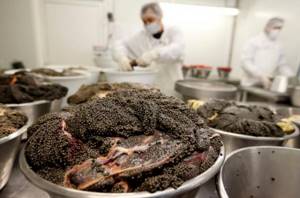
Processing black caviar
By packaging
There are only two of them:
- By weight (barrel): sold in containers. Its texture is rough, it contains harmful preservatives, and storage rules are not always followed.
- Packaged: packed in tin or glass jars. It is manufactured in compliance with standards. This caviar has a pleasant taste and delicate texture.
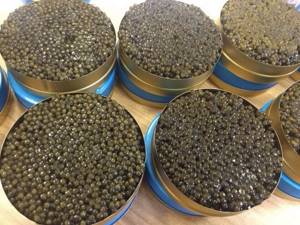
Packaged black caviar
Black caviar (beluga, sturgeon, stellate sturgeon, sterlet)
Black granular and pressed caviar has long enjoyed a well-deserved reputation as the best, most nutritious, tasty, and delicious fish product. Caviar from fish of the sturgeon family contains a significant amount of complete proteins (22-37%), fats (14-18%), vitamins A, D and group B, as well as substances necessary for the human body - lecithin and cholesterol.
It has always been divided into several varieties. So, already from the end of the 17th century. up to the 19th century. (until 1861) officially in trade practice caviar was distinguished: 1) granular
, 2)
pressed
, 3)
triple
, 4)
yastychnaya
, and each of the main types could also be divided into
commercial grades:
highest, first, second, depending on the degree of freshness and delicacy of pickling (except for yastychnaya, which was always one grade).
1. Grainy
- caviar, which is raw, immediately after catching the fish, is rubbed on a screen (sieve) so that its grains, passing through the holes of the screen, strictly corresponding to their diameter, remain intact and completely clean from the films and veins of the fish (see below). These grains in granular caviar are not connected to each other and retain a round (spherical) shape.
To produce black granular caviar, only fully ripe caviar that is easily separated from the ovaries (fish ovaries) is used. The caviar is freed from strands and films by passing through special “screens” (mesh on a frame). After punching through the screen, the granular caviar is extremely carefully, lightly (almost imperceptibly) salted. To salt this caviar, fine dry table salt is used. Salting the caviar lasts several minutes and ends when the largest amount of brine has formed - the so-called “brine”.
Properly salted caviar is called dry-crumbed caviar.
Its eggs are intact and well separated from one another.
Caviar that is under-salted is called under-salted
, and over-exposed caviar is called over-
salted
; in both cases the quality of the caviar decreases. To achieve greater storage stability, granular caviar is produced with the addition of a small amount of antiseptic substances - borax and boric acid.
The best grainy black caviar is packaged in jars and is called jarred
. Jarred caviar is the least salty, since when salting it, no more than 5% of the salt by weight of the caviar is used.

When removing the lid, the shape of the caviar protruding beyond the edge of the jar should be preserved. This allows you to immediately determine when opening the jar that the caviar is of good quality and has not been diluted in any way.
Barrel
caviar (packaged in oak barrels) is somewhat coarser and saltier Barrel grain caviar is not produced for the domestic market.
Granular caviar is lightly salted and is difficult to preserve at home; To prevent it from deteriorating, you need a temperature from 0 to minus 3°.
Pasteurized caviar is prepared from completely benign, high-grade granular black caviar.
caviar First, the granular caviar is salted (the weight of the salt should be 5% of the weight of the caviar), and then placed in small glass jars, hermetically sealed and subjected to double pasteurization. Pasteurized caviar is shelf stable - it is caviar in small glass jars, hermetically sealed and pasteurized, i.e. heated. If such a jar is not opened, it can be stored at home for a very long time; if you open it, you need to eat the caviar in one or two days.
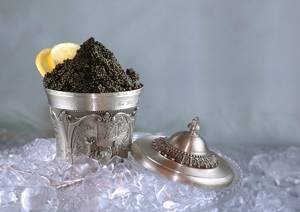
High-quality granular sturgeon caviar has a light gray, large and whole grain. The more mature the caviar, the lighter and larger the eggs and the tastier it is. Beluga eggs are usually the lightest and largest, while stellate sturgeon eggs are usually the smallest.

Light yellow caviar - albino beluga. Better than any other is
beluga granular caviar
, followed by
sturgeon
and in third place -
stellate sturgeon
, although the latter contains a slightly higher amount of fat and protein. The least valuable is sterlet caviar.
Beluga caviar
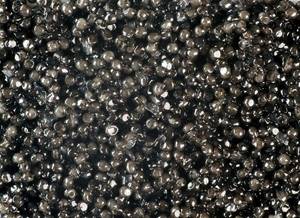
.
The most expensive beluga caviar is the “golden caviar” produced in Iran (see photo below). It is obtained from an albino beluga sturgeon, and the fish itself must be very old, almost a century old. They say that there is nothing tastier in the world. More expensive too. Iranian producers package this caviar in jars made of pure 995-carat gold, and it costs two and a half thousand dollars per hundred grams (the average cost of a kilogram of black caviar on the Western market does not exceed six hundred dollars). And this is understandable - there are not many such ancient “goldfish” left on Earth. Taste and appearance.
The aroma of caviar is elegant and rich, the taste is somewhat reminiscent of hazelnut, and there is practically no fishy smell.
Large eggs (up to 2.5 mm in diameter) literally melt in your mouth. There is a color grade for beluga caviar: “0” is dark-colored caviar, “00” is medium-dark in color, and “000” is light, usually pearl gray. Although color is not yet a guarantee of the taste of caviar, experts still assure that caviar of the “000” category has the best taste. Serving and consumption.
It is not advisable to serve caviar in metal containers, as it acquires an unpleasant aftertaste. Excellent with champagne and very chilled vodka.


Produced in Iran and packaged in jars made of thin gold leaf. Sturgeon caviar Taste and appearance.
Sturgeon caviar is smaller than beluga caviar.
The eggs are slightly yellowish or brownish (1-1.5 mm). The taste is sharper than beluga, with hints of sea and iodine. Packaged in jars with yellow lids
.
The circle of sturgeon caviar lovers is smaller than the circle of beluga caviar lovers, since it has a very specific taste: spicy, with a taste of sea and algae. Sturgeon caviar is much cheaper than beluga caviar. Serving and consumption.
Caviar is delicious on its own, without any additions. The only thing is that it must be lightly salted in order to reveal its bouquet of taste.
Sevruga caviar
Taste and appearance.
The eggs are small and black.
Although stellate sturgeon caviar is in third place in terms of value, it has an amazing taste and delicate aroma. The eggs are more elastic than beluga caviar, but, nevertheless, this does not detract from the merits of stellate sturgeon caviar. The most high-calorie due to the high fat content. Packaged in jars with red lids
.
Serving and consumption.
It is best to serve caviar on a pedestal of ice or simply on a “cushion” of crushed ice. And, of course, the dishes should not be iron, so as not to impart an unpleasant taste to the caviar.
To determine which species of sturgeon a given granular caviar belongs to,
It must be remembered that when a beluga egg is crushed, white “milk” is released and the embryonic vesicle (“eye”) is lighter in color and surrounded by a rim. When crushed, sturgeon eggs release a yellowish “milk”; the “eye” is darker than the egg itself. Sevruga caviar produces white “milk”, and its “eye” is lighter than the caviar.
Falsification of caviar.
There are quite a few ways to falsify caviar. For example, to increase weight, strongly brewed iced tea or other liquids are mixed into black granular caviar, and the eggs swell, lose strength, some of them begin to burst, and a viscous liquid appears in the caviar, which should not be in good quality caviar (the eggs should be “dry”; there should be no sediment at the bottom of the dish with caviar). To determine the quality, you should put a little caviar on a plate and blow on it - for good caviar, the eggs should easily roll over the plate and not stick to it.
2. Payusnaya
caviar - immediately after catching the fish, it is salted in
fish trays
(see below), and then laid out in lubok (small troughs) and slightly dried (aired). After this, the caviar is freed from the eggs, cleaned of all veins and mucus and crushed in vats with crushers, causing the eggs to become dense, flat and acquire a special taste arising from the combination of slightly dried (fermented) eggs with fresher, soaked, rich in salty sturgeon fat.
As a result of salting in warm brine and light pressing, this caviar turns into a homogeneous mass.
The best pressed caviar is stellate sturgeon.
It has a delicate oily taste and a very delicate aroma.
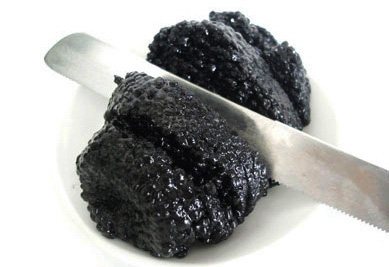
Pressed caviar made in Iran.
Pressed caviar is in terms of taste the best, most pleasant, tasty, although in the former Soviet trade it was always cheaper than granular caviar, which was considered more “beautiful”, i.e. had a better appearance, marketable appearance. In fact, pressed caviar is not only the most delicious, but also the most durable in terms of preservation.
Currently, pressed caviar is very rarely found on sale in Russia, and it is the most expensive.

3.
Trinity (or rather, ternary) caviar was prepared rarely before, on special order, for amateurs, mainly in Moscow. To obtain it, fresh caviar, having been removed from the fish, was immediately rubbed on a screen, just like granular caviar, but then not added with salt, but quickly doused in a trough with warm strong brine, and, having carefully stirred the caviar in it, they threw it onto a sieve, allowing it to drain completely the brine by gravity, no matter how long it takes. Only after complete dehydration of the caviar was it carefully and hermetically packed into barrels (one pound each) and immediately sent to Moscow by postal troika, i.e., as quickly as possible in those days. This is where its name came from - triple. Now this caviar is produced in Russia in small quantities only for special occasions.
4. Yastychnaya
caviar is prepared in the most simple way: it is salted together with the brine, without even tearing it, and it is salted rather steeply and left in the brine until consumed. Once upon a time it was caviar for the poor people, just to “salt”, to eat quickly with bread, and not to get pleasure. Worse or somewhat defective specimens of fish, or caviar from fish that was not the first freshness, were used for spawn caviar.
NOTE. Yastyk
- a thin but durable film that forms a shell bag in which the caviar of salmon and sturgeon fish is located.
The presence or absence of a crust when salting caviar plays a significant role in shaping its quality and appearance (red and black caviar) as a finished product. Caviar, freed from the rack before salting, is of the highest quality, the so-called granular
(black) and, as a rule, all red.
Caviar, which is salted directly in the eggs, but lies in them for no more than a day and is then freed from the eggs on a screen, is called pressed caviar
and is prepared only from sturgeon. It is of high quality, but requires a greater degree of processing and is denser in volume, which is unprofitable when selling it.
Yastik caviar
- which is salted in jars and goes on sale in this unrefined form. It is of low quality, often over-salted, sometimes has a matted, compacted, dried appearance and consistency and is naturally valued much cheaper (three times!) than granular and pressed ones.
Yastichny caviar is either the result of a rush during poutine, or an irresponsible, negligent attitude towards a valuable product. Jasty caviar is black and very rarely red. It is no longer possible to separate it from the roes, and in the process of eating you have to either eat part of the roes as a “by-product” or spit them out, which forces the roes to be sold at a low price and to the unpretentious public, although in nutritional terms it is a complete and very healthy product.
How to choose the right one
- First, focus on the price. Too low a price raises suspicions: high-quality sturgeon caviar simply cannot be cheap.
- Secondly, carefully inspect the product. If you buy it in canned form, shake the container: the caviar should not dangle. In a glass container it is convenient to evaluate the appearance of the delicacy: are the eggs even, not wrinkled, of the same shade and size? Pay attention to the presence of preservatives: ideally there should be no more than two.
- Thirdly, real delicacies are certified. Conscientious sellers can always provide supporting documents.
Why so expensive
Producing real caviar is a labor-intensive process. In natural reservoirs, sturgeon were diligently exterminated, but in fish farms, it takes a lot of effort and money to raise a healthy, mature individual.
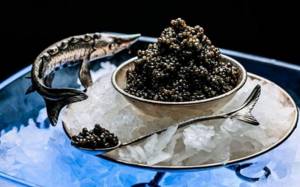
Served black caviar
The price is also determined by the type of sturgeon. The most expensive is beluga, the most affordable is sterlet. We wish you happy shopping!

